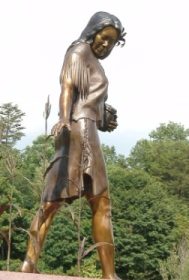Cherokee Agriculture
The beginning of Cherokee culture is identified with the cultivation of corn by the native people in the Southern  Appalachians more than a thousand years ago.
Appalachians more than a thousand years ago.
By the 1820s, due to the influence of the encroaching European immigrant culture, many Cherokee abandoned their traditional towns and were living in family groups in log cabins along streams and river valleys. Even though the land was still owned communally, the Cherokee practiced a type of subsistence agriculture on small farms usually ranging in size from two to ten acres.
http://www.blueridgeheritage.com/heritage/agriculture/cherokee-agriculture
 Appalachians more than a thousand years ago.
Appalachians more than a thousand years ago. Selu
From the earliest times in Cherokee history, the raising of corn was interwoven with the spiritual beliefs of the people. Indeed, the Cherokee name for corn—"selu"—is also the name of the First Woman in Cherokee creation stories.Cherokee villages were surrounded by vast cornfields while gardens were planted beside rivers and streams. In addition to corn, the Cherokee grew beans, squash, sunflowers, pumpkins, and other crops. Cherokee women were the primary farmers.
After European Contact
After the arrival of Europeans, the Cherokee began growing peaches and watermelons acquired through trade. Cherokees began keeping and breeding horses circa 1720, and by the mid-1700s they were growing apples from Europe, black-eyed peas from Africa, and sweet potatoes from the Caribbean. Eventually, cattle were included among Cherokee livestock.By the 1820s, due to the influence of the encroaching European immigrant culture, many Cherokee abandoned their traditional towns and were living in family groups in log cabins along streams and river valleys. Even though the land was still owned communally, the Cherokee practiced a type of subsistence agriculture on small farms usually ranging in size from two to ten acres.
http://www.blueridgeheritage.com/heritage/agriculture/cherokee-agriculture
No comments:
Post a Comment